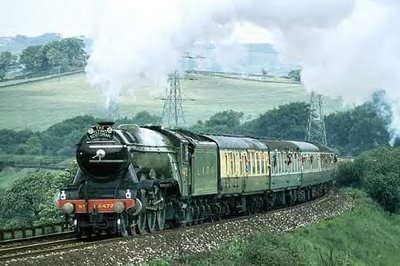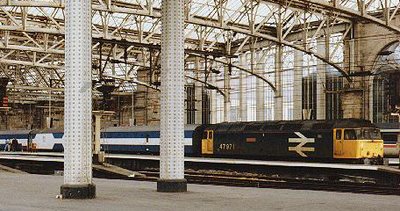The Great North Road
Once the haunt of Highwaymen and connecting London with Edinburgh some 409 miles later, the Great North Road was the first road in Britain to incur a toll. In 1663 turnpike gates were errected in Hertfordshire, though of the three gates used, two were easily avoidable apparently. Unlike Highwaymen.
For most of its length the Great North Road is accompanied by the East Coast Main Line. But unlike the Great North Road, which was mainly a muddy track having evolved through time and trees, the East Coast Main Line was run by three companies: the North British Railway, the North Eastern Railway and the Great Northern Railway.
In 1860 they formed the East Coast Joint Stock to allow passengers to travel the entire route without changing carriages. Unlike the Great North Road which sported great coaching inns along its route where travellers would rest for the night while horses and carriages were changed and Highwaymen went through their luggage.
In 1923 the three railway companies merged to form the London and North Eastern Railway, the famous LNER. Today the East Coast Main Line is mainly operated by the Great North Eastern Railway, GNER.
The East Coast Main Line was the route for the record breaking non-stop run of the Flying Scotsman, which sported the green livery of the LNER.

the Flying Scotsman
The other Green Livery came from Lincoln and was mainly sported by Merry Men as they went their merry way following Robin of Loxleigh about in the Forests of Sherwood.

a forest similar to one containing Merry Men
Both the Great North Road and the East Coast Main Line would pass through Sherwood Forest if Sherwood Forest was the wood it was. Robin Hood has a train named after him, unlike Dick Turpin, who doesn't.

Midland mailine: The Robin Hood
The Great North Road was the route of the famous ride by Dick Turpin from London to York, on his trusty steed Black Bess. But unlike the Flying Scotsman this was entirely fictitious, being made up by one William Harrison Ainsworth for his novel Rookwood [1834]
Though Highwaymen plagued the travellers of the Great North Road, they didn't cause much disruption to the East Coast Main Line, largely due to the excessive speeds and general unstoppableness of the trains, but mainly due to the protagonists [Highwaymen and Trains] missing each other by about 100 years. The main disruption to the East Coast Main Line is caused by the wind blowing down power lines.
conclusion of the foregoing:
The Flying Scotsman weighs nearly 100 tonnes and could reach speeds of 100mph. In its working life the engine has travelled some 2.4 million miles. It has recently been sold for 2.2 million pounds to the National Railway Museum, in York, the city in which Dick Turpin was hanged.
Though he hasn't got a train named after him Dick Turpin has a lot of pubs he never visited named after him.
Though Robin Hood stopped travellers on the highway and demanded all their money, he is not generally considered a Highwayman.
Robin Hood was played throughout this post by Errol Flynn.

Unlike Dick Turpin, who was played by Richard O'Sullivan.

For most of its length the Great North Road is accompanied by the East Coast Main Line. But unlike the Great North Road, which was mainly a muddy track having evolved through time and trees, the East Coast Main Line was run by three companies: the North British Railway, the North Eastern Railway and the Great Northern Railway.
In 1860 they formed the East Coast Joint Stock to allow passengers to travel the entire route without changing carriages. Unlike the Great North Road which sported great coaching inns along its route where travellers would rest for the night while horses and carriages were changed and Highwaymen went through their luggage.
In 1923 the three railway companies merged to form the London and North Eastern Railway, the famous LNER. Today the East Coast Main Line is mainly operated by the Great North Eastern Railway, GNER.
The East Coast Main Line was the route for the record breaking non-stop run of the Flying Scotsman, which sported the green livery of the LNER.

the Flying Scotsman
The other Green Livery came from Lincoln and was mainly sported by Merry Men as they went their merry way following Robin of Loxleigh about in the Forests of Sherwood.

a forest similar to one containing Merry Men
Both the Great North Road and the East Coast Main Line would pass through Sherwood Forest if Sherwood Forest was the wood it was. Robin Hood has a train named after him, unlike Dick Turpin, who doesn't.

Midland mailine: The Robin Hood
The Great North Road was the route of the famous ride by Dick Turpin from London to York, on his trusty steed Black Bess. But unlike the Flying Scotsman this was entirely fictitious, being made up by one William Harrison Ainsworth for his novel Rookwood [1834]
Though Highwaymen plagued the travellers of the Great North Road, they didn't cause much disruption to the East Coast Main Line, largely due to the excessive speeds and general unstoppableness of the trains, but mainly due to the protagonists [Highwaymen and Trains] missing each other by about 100 years. The main disruption to the East Coast Main Line is caused by the wind blowing down power lines.
conclusion of the foregoing:
The Flying Scotsman weighs nearly 100 tonnes and could reach speeds of 100mph. In its working life the engine has travelled some 2.4 million miles. It has recently been sold for 2.2 million pounds to the National Railway Museum, in York, the city in which Dick Turpin was hanged.
Though he hasn't got a train named after him Dick Turpin has a lot of pubs he never visited named after him.
Though Robin Hood stopped travellers on the highway and demanded all their money, he is not generally considered a Highwayman.
Robin Hood was played throughout this post by Errol Flynn.

Unlike Dick Turpin, who was played by Richard O'Sullivan.


0 Comments:
Post a Comment
<< Home